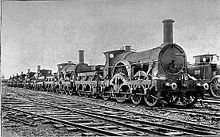This is an old revision of this page, as edited by Iain Bell (talk | contribs) at 19:56, 16 February 2009 (+cat:4-2-2 locomotives|). The present address (URL) is a permanent link to this revision, which may differ significantly from the current revision.
Revision as of 19:56, 16 February 2009 by Iain Bell (talk | contribs) (+cat:4-2-2 locomotives|)(diff) ← Previous revision | Latest revision (diff) | Newer revision → (diff)
Under the Whyte notation for the classification of steam locomotives, a 4-2-2 locomotive has four leading wheels, two driving wheels and two trailing wheels.
Other equivalent classifications are:
UIC classification: 2A1 (also known as German classification and Italian classification)
French classification: 211
Turkish classification: 14
Swiss classification: 1/4
Like other steam locomotive types with single pairs of driving wheels, they were also known as singles.
Examples from the UK
- The Iron Duke class of Great Western Railway, built by Daniel Gooch. This broad gauge express locomotives were first built in 1847 and had an 8 ft diameter driving wheel size.
- The later examples of the GWR 3031 Class by William Dean, 1893-1899, built for standard gauge. No 3065 Duke of Connaught made a record-breaking run with the Ocean Mail express train on 9 May 1904, covering the distance from Plymouth to Paddington in 227 minutes.
- The GNR Stirling 4-2-2 of the Great Northern Railway, which ran an average speed of more than 60 mph during the race to the north, built first in 1870. They were called eight-footer because of the big driving wheel, that was more than 8 ft. in diameter.
- The Midland Railway's 115 class "Spinners". One, No. 673, survives at the National Railway Museum, York.
- A further notable UK class 4-2-2 is the GER Class P43, which was an early oil-burning engine, developed by the pioneer of oil-boilers, James Holden

Examples from Germany

| Steam locomotive wheel arrangements (Whyte notation) | |
|---|---|
| Single engine types |
|
| Divided drive and Duplex engine types | |
| Articulated locomotives Fairlie, Meyer and Garratt types | |
| Articulated locomotives Mallet types | |
| Articulated locomotives Triplex and other Multiplex types | |
| Articulated locomotives Engerth types | |
| Geared locomotives | |
This steam locomotive-related article is a stub. You can help Misplaced Pages by expanding it. |